Wind Energy Integration through District Heating. A Wind Resource Based Approach
Abstract
:1. Introduction
2. Literature Review
3. Proposed Methodology
3.1. Site Experimental Results
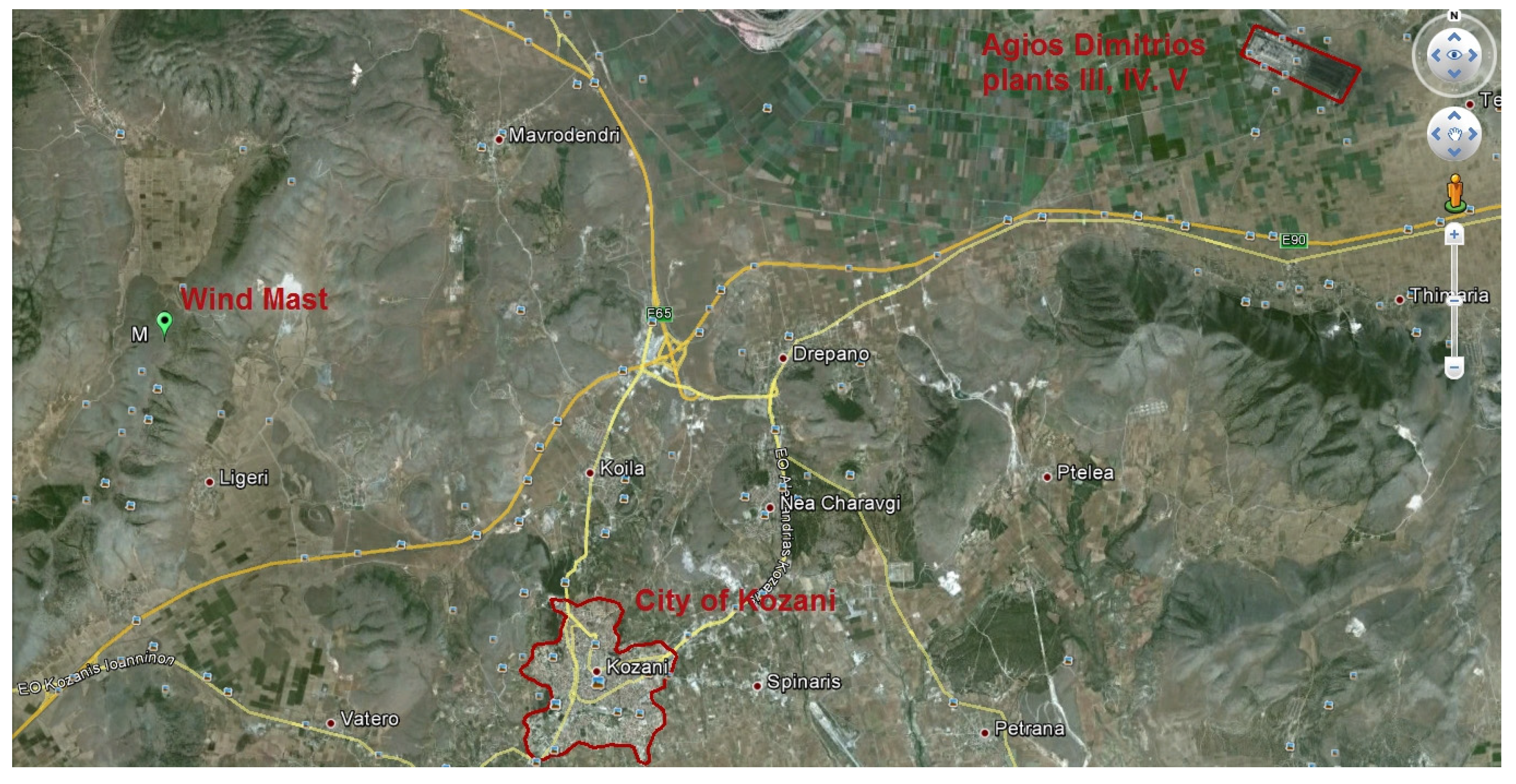
| Latitude (°) | Longitude (°) | Mean Speed (m·s−1) | Period of Data Analysis | Height (m.a.g.l.) | Turbulence Intensity (T.I.) at 10m. |
|---|---|---|---|---|---|
| 40°21'2" N | 21°42'23" E | 5.4 at 10 m | 17 December 2006 to 17 December 2007 | 1093 | 11.19% |
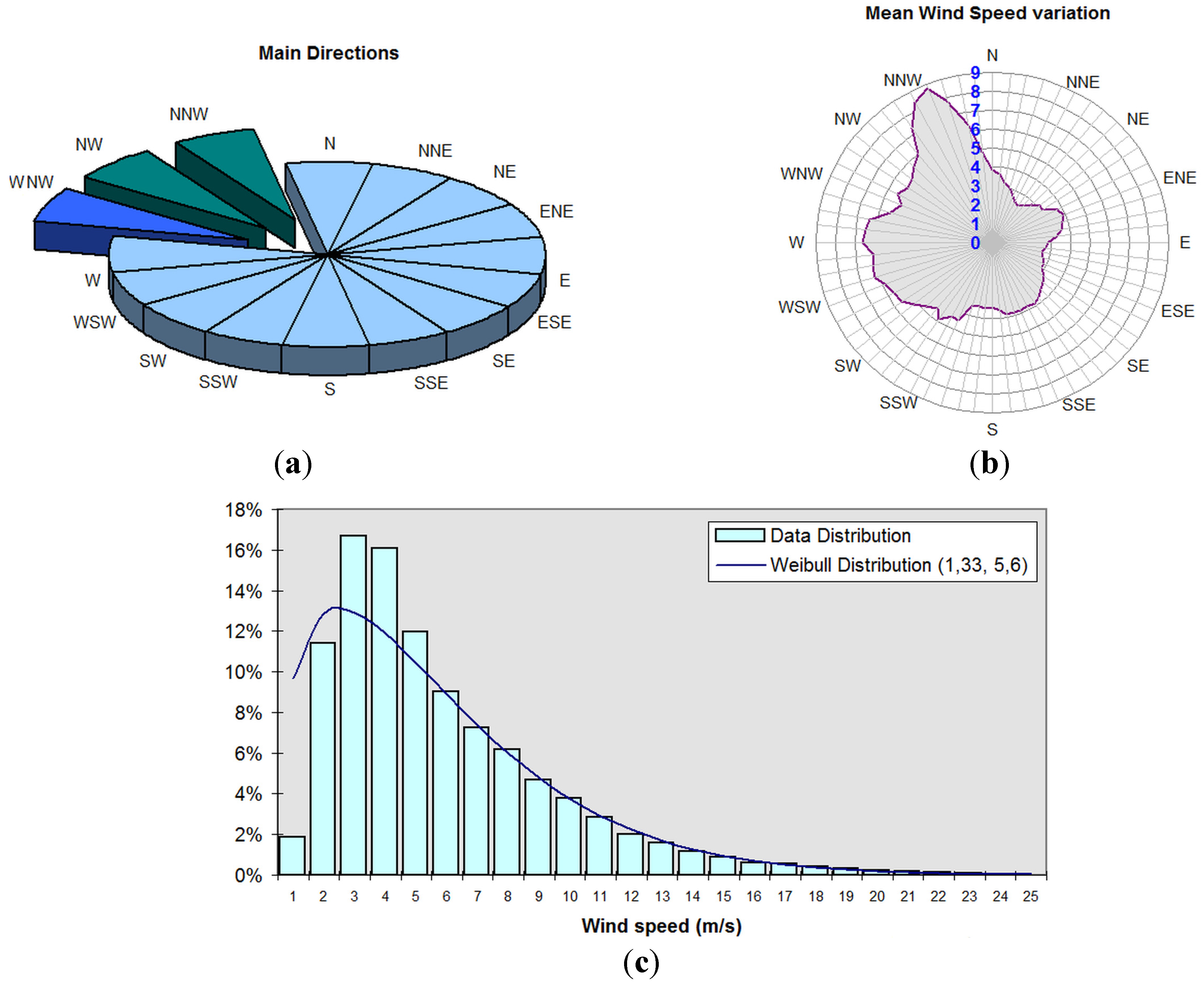
| Direction | Angles (°) | Weibull Shape | Weibull Scale | Data Distrib | Mean Wind Speed (m/s) | T.I. at 10 m/s |
|---|---|---|---|---|---|---|
| NNE | 11.25–33.75 | 1.24 | 2.48 | 1.29% | 2.8 | 9.9 |
| NE | 33.75–56.25 | 1.16 | 2.47 | 1.24% | 2.8 | 11.2 |
| ENE | 56.25–78.75 | 1.9 | 4.29 | 2.41% | 3.7 | 12.3 |
| E | 78.75–101.25 | 1.39 | 2.82 | 2.27% | 3 | 13.3 |
| ESE | 101.25–123.75 | 1.4 | 2.55 | 3.18% | 2.8 | 15 |
| SE | 123.75–146.25 | 1.78 | 3.55 | 6.95% | 3.6 | 16.8 |
| SSE | 146.25–168.75 | 1.43 | 3.51 | 10.00% | 3.8 | 13 |
| S | 168.75–191.25 | 0.87 | 2.17 | 6.06% | 3.5 | 13.1 |
| SSW | 191.25–213.75 | 1.3 | 4.16 | 4.79% | 4.2 | 12.8 |
| SW | 213.75–236.25 | 1.26 | 4.95 | 5.48% | 4.9 | 12.6 |
| WSW | 236.25–258.75 | 1.64 | 6.65 | 5.34% | 5.9 | 13.2 |
| W | 258.75–281.25 | 1.69 | 7.23 | 4.09% | 6.4 | 11.4 |
| WNW | 281.25–303.75 | 1.58 | 5.68 | 11.61% | 5.2 | 11.3 |
| NW | 303.75–326.25 | 1.68 | 6.6 | 9.38% | 6 | 9.6 |
| NNW | 326.25–348.75 | 2.01 | 9.24 | 22.10% | 8.2 | 10.8 |
| N | 348.75–11.25 | 1.28 | 4.68 | 3.81% | 4.6 | 11.2 |
3.2. Wind Resource Analysis and Planning
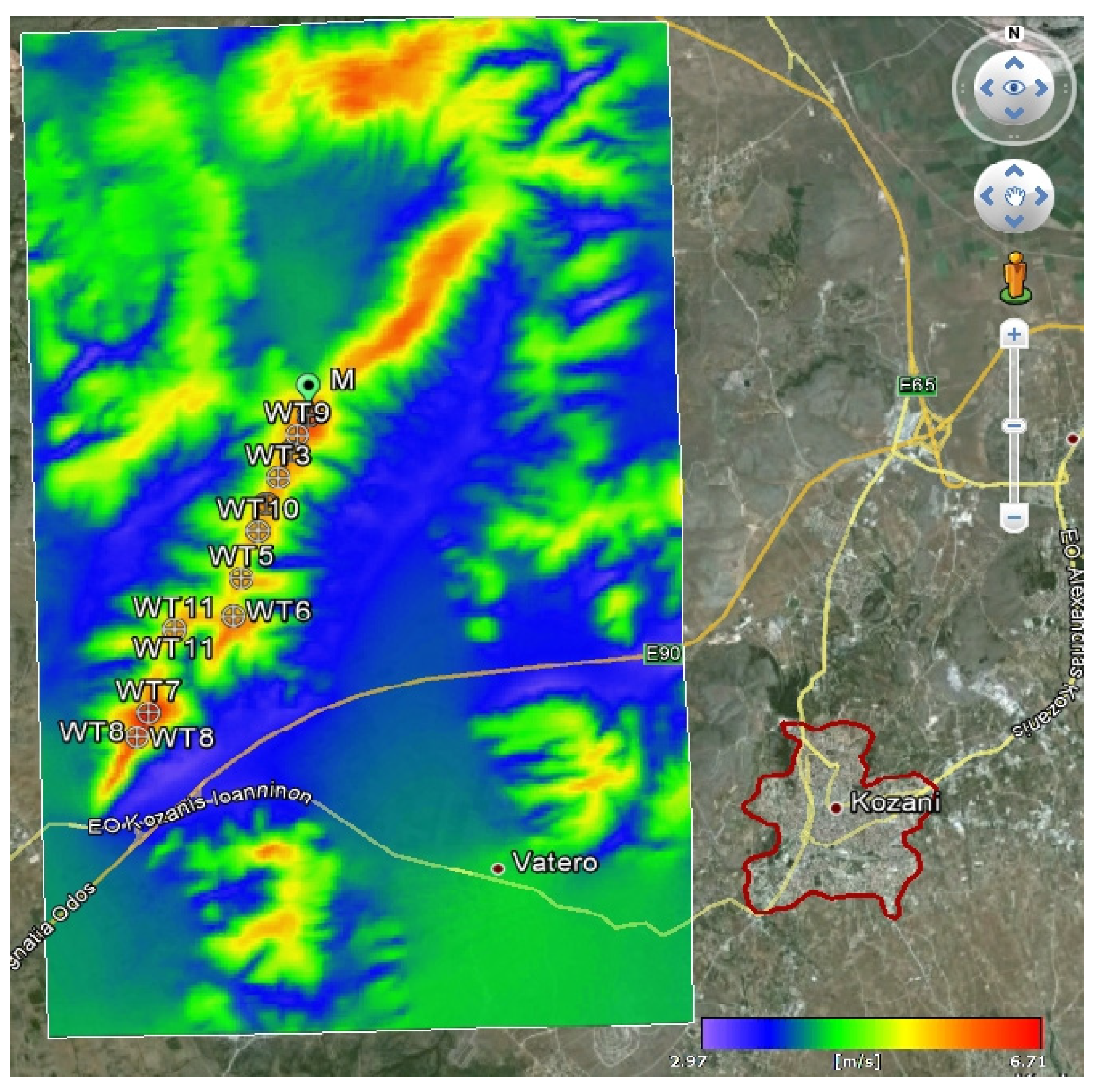
| Municipalities | Surface (km2) | Max Allowed No. of WT | WT Licensed | WT Applications |
|---|---|---|---|---|
| Voiou | 771.05 | 508.89 | 136.69 | 131.00 |
| Eordeas | 708.80 | 467.80 | 210.32 | 407.00 |
| Kozanis | 971.33 | 641.08 | 108.26 | 131.00 |
| Servion–Velventou | 548.10 | 361.74 | 23.74 | 49.00 |
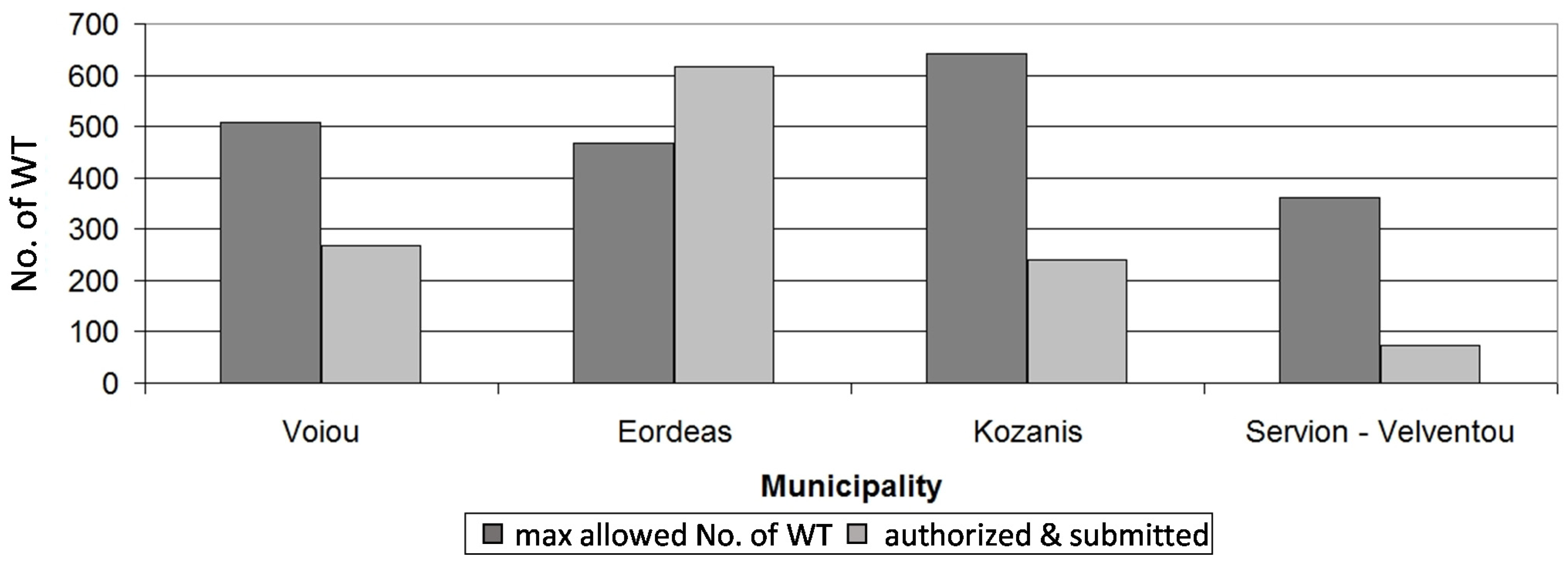
4. Case Study in Kozani Region
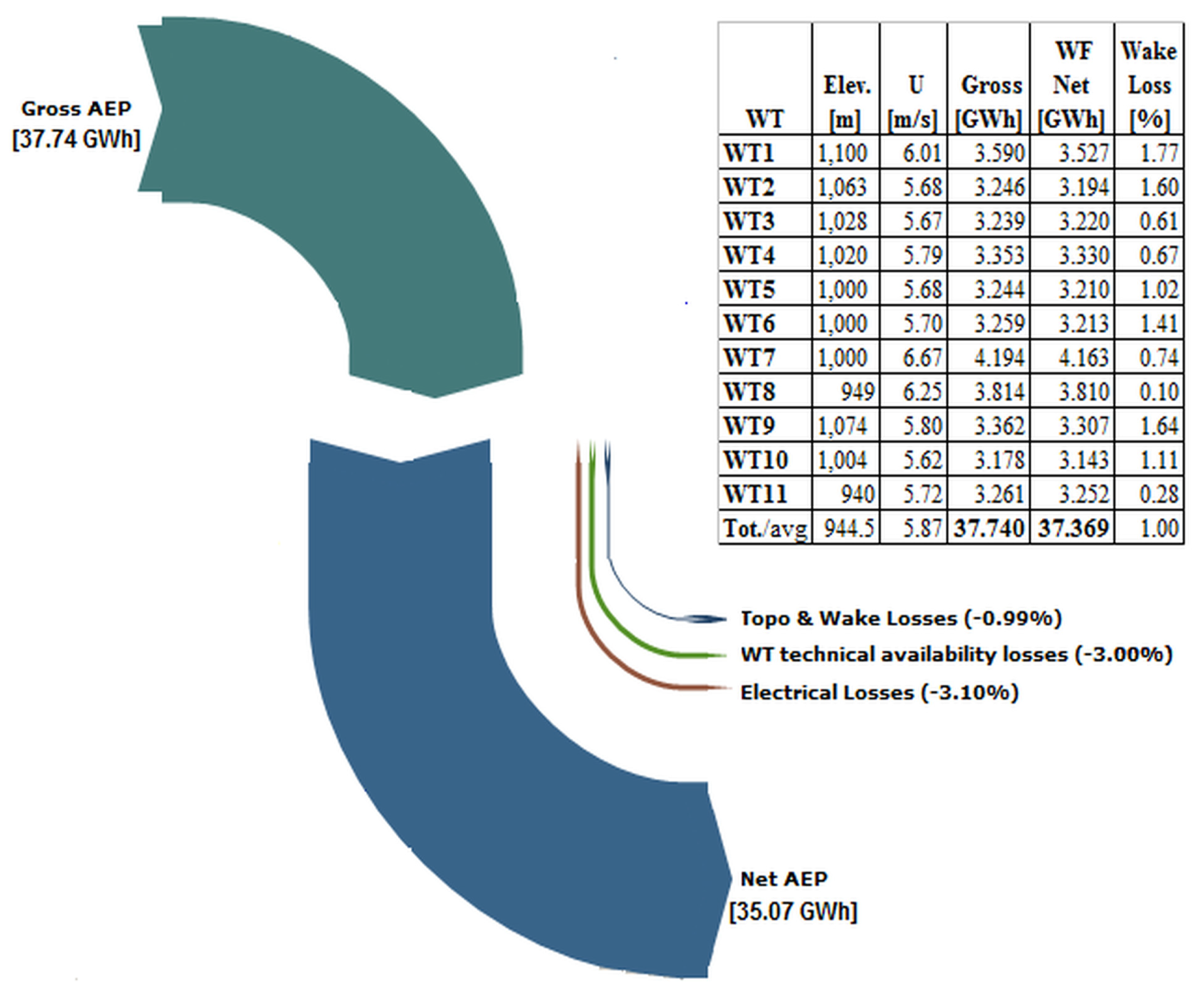
5. Results and Discussion
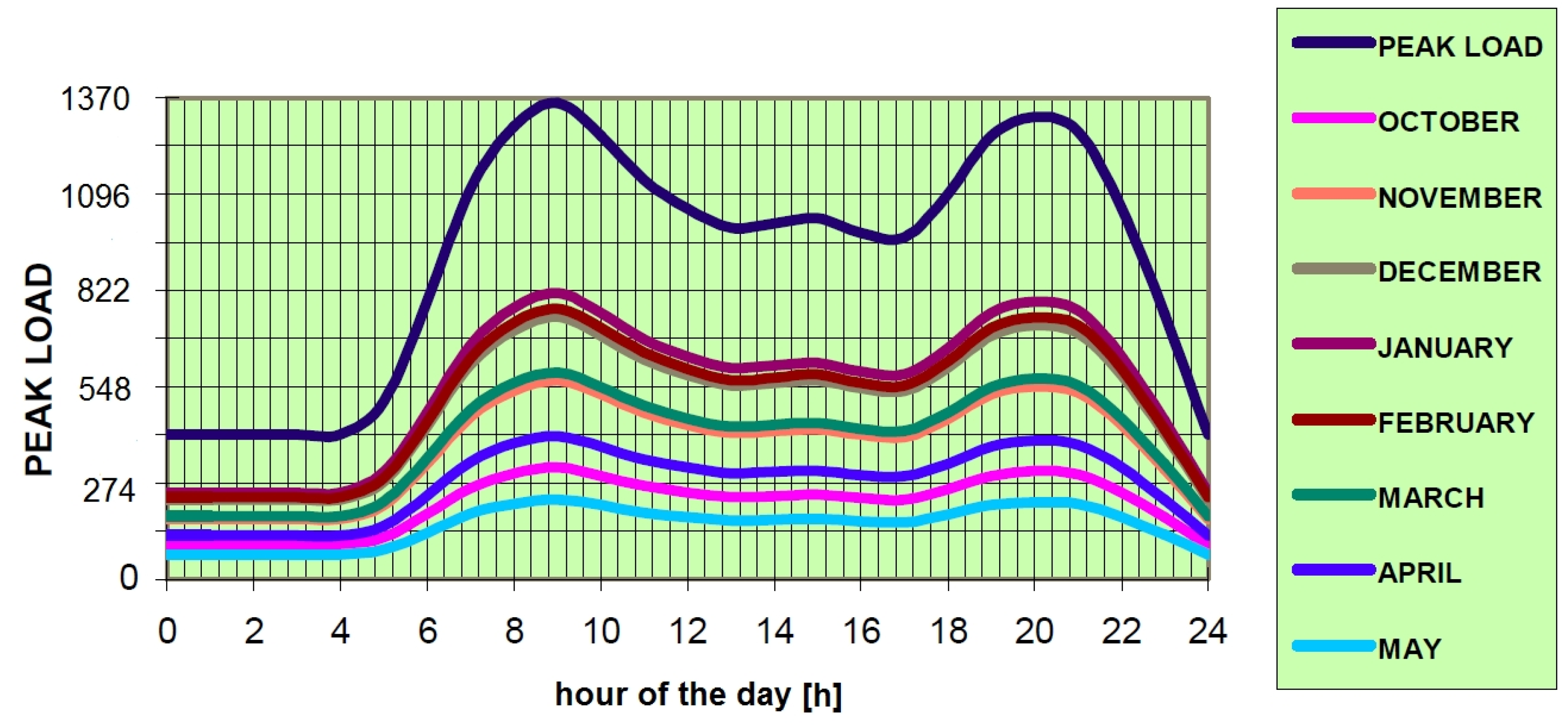
- (a)
- Regardless of the wind power curtailment rate, there is a realizable line (which represents what could happen in real life) that covers part of the needs of the peak load for every hour.
- (b)
- At night and in the early morning, curtailed wind can cover higher amounts of heating needs.
- (c)
- In May, the heating needs are so low that they can be almost totally covered from wind curtailment.
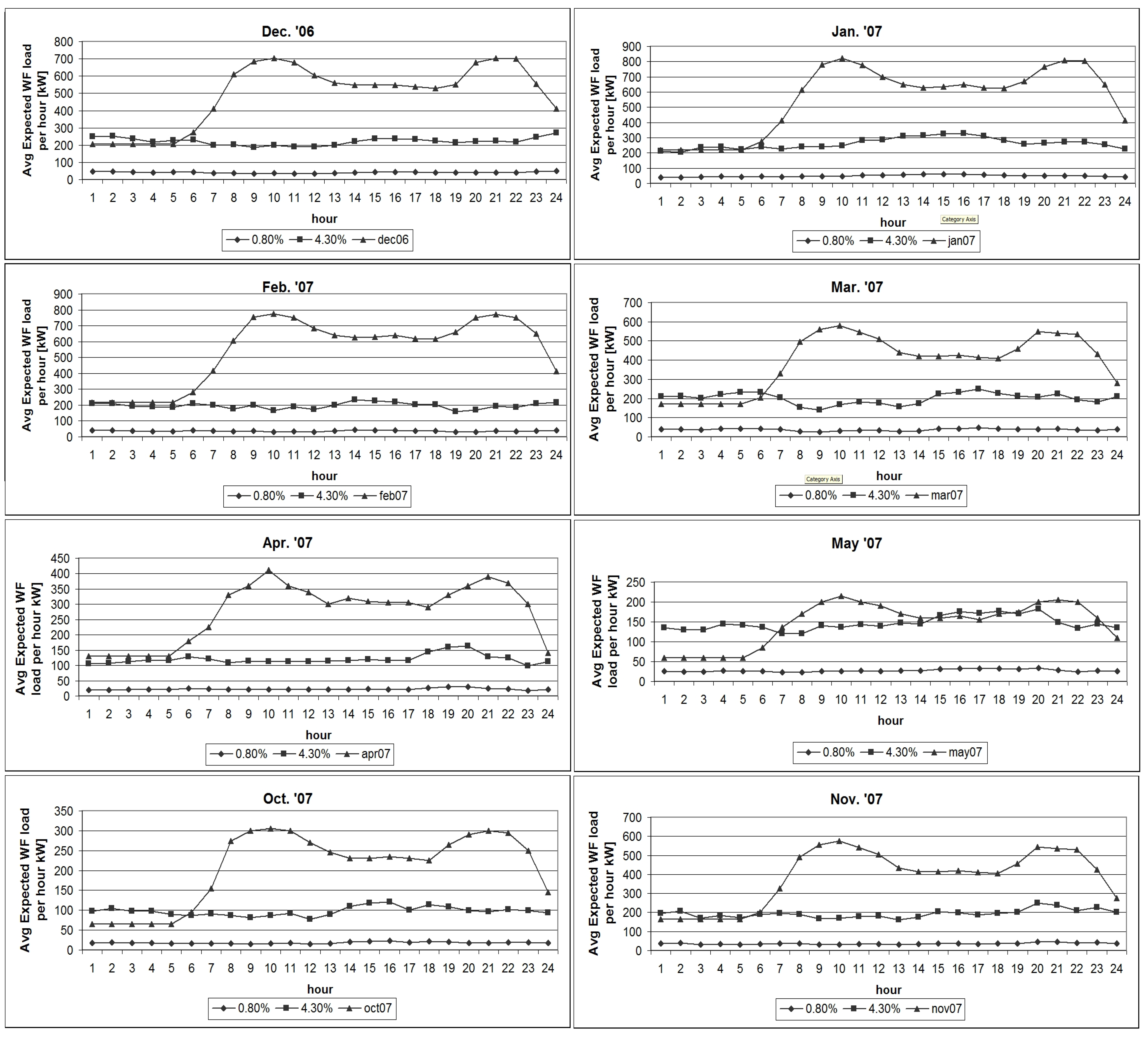
| Initial Scenario | Scenario 1 | Scenario 2 | Scenario 3 | |
|---|---|---|---|---|
| Net Present Value (NPV) (T€) | 16,399 | 16,439 | 16,688 | 16,760 |
| Balance (T€) | 10,386 | 10,426 | 10,676 | 10,748 |
| Internal Rate of Return (IRR) | 12.42% | 12.47% | 12.78% | 12.87% |
| full repayment (yrs) | 9 | 9 | 9 | 9 |
6. Conclusions
Acknowledgments
Appendix
| December 2006 | |||||||||||||||||||||||
| 5804 | 5836 | 5505 | 5073 | 5301 | 5382 | 4652 | 4678 | 4344 | 4611 | 4392 | 4445 | 4662 | 5118 | 5489 | 5490 | 5453 | 5192 | 4970 | 5108 | 5245 | 5074 | 5744 | 6313 |
| 46 | 47 | 44 | 41 | 42 | 43 | 37 | 37 | 35 | 37 | 35 | 36 | 37 | 41 | 44 | 44 | 44 | 42 | 40 | 41 | 42 | 41 | 46 | 51 |
| 250 | 251 | 237 | 218 | 228 | 231 | 200 | 201 | 187 | 198 | 189 | 191 | 200 | 220 | 236 | 236 | 234 | 223 | 214 | 220 | 226 | 218 | 247 | 271 |
| 205 | 205 | 205 | 205 | 205 | 274 | 411 | 610 | 685 | 705 | 680 | 605 | 560 | 548 | 548 | 548 | 540 | 530 | 550 | 680 | 705 | 700 | 555 | 410 |
| January 2007 | |||||||||||||||||||||||
| 4885 | 4752 | 5507 | 5555 | 5180 | 5583 | 5267 | 5547 | 5582 | 5771 | 6536 | 6649 | 7252 | 7282 | 7515 | 7605 | 7186 | 6568 | 6015 | 6189 | 6323 | 6310 | 5937 | 5234 |
| 39 | 38 | 44 | 44 | 41 | 45 | 42 | 44 | 45 | 46 | 52 | 53 | 58 | 58 | 60 | 61 | 57 | 53 | 48 | 50 | 51 | 50 | 47 | 42 |
| 210 | 204 | 237 | 239 | 223 | 240 | 226 | 239 | 240 | 248 | 281 | 286 | 312 | 313 | 323 | 327 | 309 | 282 | 259 | 266 | 272 | 271 | 255 | 225 |
| 218 | 218 | 218 | 218 | 218 | 277 | 414 | 613 | 780 | 822 | 775 | 700 | 650 | 630 | 635 | 650 | 630 | 625 | 670 | 765 | 810 | 805 | 650 | 414 |
| February 2007 | |||||||||||||||||||||||
| 4916 | 4905 | 4521 | 4439 | 4308 | 4900 | 4628 | 4115 | 4613 | 3836 | 4377 | 3977 | 4675 | 5406 | 5263 | 5110 | 4721 | 4731 | 3731 | 3902 | 4522 | 4315 | 4855 | 5029 |
| 39 | 39 | 36 | 36 | 34 | 39 | 37 | 33 | 37 | 31 | 35 | 32 | 37 | 43 | 42 | 41 | 38 | 38 | 30 | 31 | 36 | 35 | 39 | 40 |
| 211 | 211 | 194 | 191 | 185 | 211 | 199 | 177 | 198 | 165 | 188 | 171 | 201 | 232 | 226 | 220 | 203 | 203 | 160 | 168 | 194 | 186 | 209 | 216 |
| 218 | 218 | 218 | 218 | 218 | 280 | 417 | 606 | 756 | 775 | 750 | 685 | 640 | 625 | 630 | 640 | 620 | 615 | 660 | 750 | 770 | 750 | 650 | 414 |
| March 2007 | |||||||||||||||||||||||
| 4857 | 4955 | 4663 | 5155 | 5405 | 5393 | 4745 | 3550 | 3232 | 3921 | 4246 | 4091 | 3673 | 4014 | 5208 | 5412 | 5827 | 5293 | 4944 | 4809 | 5223 | 4469 | 4239 | 4882 |
| 39 | 40 | 37 | 41 | 43 | 43 | 38 | 28 | 26 | 31 | 34 | 33 | 29 | 32 | 42 | 43 | 47 | 42 | 40 | 38 | 42 | 36 | 34 | 39 |
| 209 | 213 | 201 | 222 | 232 | 232 | 204 | 153 | 139 | 169 | 183 | 176 | 158 | 173 | 224 | 233 | 251 | 228 | 213 | 207 | 225 | 192 | 182 | 210 |
| 170 | 170 | 170 | 170 | 170 | 205 | 330 | 495 | 560 | 580 | 545 | 510 | 440 | 420 | 420 | 425 | 415 | 410 | 460 | 550 | 540 | 535 | 430 | 280 |
| April 2007 | |||||||||||||||||||||||
| 2453 | 2490 | 2617 | 2721 | 2717 | 3001 | 2816 | 2550 | 2671 | 2627 | 2615 | 2609 | 2640 | 2694 | 2796 | 2713 | 2713 | 3337 | 3709 | 3804 | 2996 | 2885 | 2301 | 2629 |
| 20 | 20 | 21 | 22 | 22 | 24 | 23 | 20 | 21 | 21 | 21 | 21 | 21 | 22 | 22 | 22 | 22 | 27 | 30 | 30 | 24 | 23 | 18 | 21 |
| 105 | 107 | 113 | 117 | 117 | 129 | 121 | 110 | 115 | 113 | 112 | 112 | 114 | 116 | 120 | 117 | 117 | 143 | 160 | 164 | 129 | 124 | 99 | 113 |
| 130 | 130 | 130 | 130 | 130 | 180 | 225 | 330 | 360 | 411 | 360 | 340 | 300 | 320 | 310 | 305 | 305 | 290 | 330 | 360 | 390 | 370 | 300 | 140 |
| May 2007 | |||||||||||||||||||||||
| 3137 | 3029 | 3022 | 3373 | 3289 | 3162 | 2808 | 2805 | 3279 | 3189 | 3340 | 3252 | 3426 | 3375 | 3871 | 4070 | 3989 | 4131 | 3958 | 4237 | 3469 | 3100 | 3374 | 3140 |
| 25 | 24 | 24 | 27 | 26 | 25 | 22 | 22 | 26 | 26 | 27 | 26 | 27 | 27 | 31 | 33 | 32 | 33 | 32 | 34 | 28 | 25 | 27 | 25 |
| 135 | 130 | 130 | 145 | 141 | 136 | 121 | 121 | 141 | 137 | 144 | 140 | 147 | 145 | 166 | 175 | 172 | 178 | 170 | 182 | 149 | 133 | 145 | 135 |
| 60 | 60 | 60 | 60 | 60 | 85 | 137 | 170 | 200 | 215 | 200 | 190 | 170 | 160 | 160 | 165 | 155 | 170 | 175 | 200 | 205 | 200 | 160 | 110 |
| October 2007 | |||||||||||||||||||||||
| 2259 | 2440 | 2276 | 2285 | 2093 | 2011 | 2117 | 2030 | 1897 | 2029 | 2148 | 1802 | 2069 | 2564 | 2735 | 2801 | 2327 | 2651 | 2529 | 2289 | 2244 | 2365 | 2319 | 2172 |
| 18 | 20 | 18 | 18 | 17 | 16 | 17 | 16 | 15 | 16 | 17 | 14 | 17 | 21 | 22 | 22 | 19 | 21 | 20 | 18 | 18 | 19 | 19 | 17 |
| 97 | 105 | 98 | 98 | 90 | 86 | 91 | 87 | 82 | 87 | 92 | 77 | 89 | 110 | 118 | 120 | 100 | 114 | 109 | 98 | 96 | 102 | 100 | 93 |
| 65 | 65 | 65 | 65 | 65 | 95 | 155 | 274 | 300 | 305 | 300 | 270 | 245 | 230 | 230 | 235 | 230 | 225 | 265 | 290 | 300 | 295 | 250 | 145 |
| November 2007 | |||||||||||||||||||||||
| 4539 | 4842 | 3972 | 4265 | 4053 | 4407 | 4529 | 4432 | 3904 | 3966 | 4120 | 4191 | 3755 | 4092 | 4724 | 4610 | 4371 | 4530 | 4654 | 5823 | 5543 | 4907 | 5243 | 4664 |
| 36 | 39 | 32 | 34 | 32 | 35 | 36 | 35 | 31 | 32 | 33 | 34 | 30 | 33 | 38 | 37 | 35 | 36 | 37 | 47 | 44 | 39 | 42 | 37 |
| 195 | 208 | 171 | 183 | 174 | 189 | 195 | 191 | 168 | 171 | 177 | 180 | 161 | 176 | 203 | 198 | 188 | 195 | 200 | 250 | 238 | 211 | 225 | 201 |
| 165 | 165 | 165 | 165 | 165 | 200 | 325 | 490 | 555 | 575 | 540 | 505 | 435 | 415 | 415 | 420 | 410 | 405 | 455 | 545 | 535 | 530 | 425 | 275 |
Conflicts of Interest
References
- Municipal Enterprise for Water Supply and Sewerage of Kozani (DEYAK). 2012. Available online: http://www.deyakozanis.gr/?page_id=7 (accessed on 1 December 2012).
- Sonne, P. Kozani—A Success Story in the District Heating World; Danish Board of District Heating (DBDH): Frederiksberg, Denmark, 2006. [Google Scholar]
- Regulatory Authority for Energy. RES Statistics. 2012. Available online: http://www.rae.gr/site/file/categories_new/renewable_power/licence/statistics/info?p=files&i=0 (accessed on 1 January 2013).
- Niemi, R.; Mikkola, J.; Lund, P.D. Urban energy systems with smart multi-carrier energy networks and renewable energy generation. Renew. Energy 2012, 48, 524–536. [Google Scholar] [CrossRef]
- Long, H.; Xu, R.; He, J. Incorporating the variability of wind Power with Electric heat pumps. Energies 2011, 4, 1748–1762. [Google Scholar] [CrossRef]
- Maegaard, P. Balancing fluctuating power sources. In Proceedings of 2010 World Non-Grid-Connected Wind Power and Energy Conference (WNWEC), Nanjing, China, 5–7 November 2010; pp. 4–7.
- Hong, L.; Lund, H.; Möller, B. The importance of flexible power plant operation for Jiangsu’s wind integration. Energy 2012, 41, 499–507. [Google Scholar] [CrossRef]
- Mathiesen, B.V.; Lund, H.; Connolly, D. Limiting biomass consumption for heating in 100% renewable energy systems. Energy 2012, 48, 160–168. [Google Scholar] [CrossRef]
- Lund, H.; Möller, B.; Mathiesen, B.V.; Dyrelund, A. The role of district heating in future renewable energy systems. Energy 2010, 35, 1381–1390. [Google Scholar] [CrossRef]
- Mathiesen, B.V.; Lund, H. Comparative analyses of seven technologies to facilitate the integration of fluctuating renewable energy sources. Renew. Power Gener. 2009, 3, 190–204. [Google Scholar] [CrossRef]
- Fitzgerald, N.; Foley, A.M.; McKeogh, E. Integrating wind power using intelligent electric water heating. Energy 2012, 48, 135–143. [Google Scholar] [CrossRef]
- Mortensen, N.G.; Landsberg, L.; Troen, I.; Petersen, E.L. Wind Atlas Analysis and Application Program (WAsP); Risø Nat. Labs: Roskilde, Denmark, 1993; p. 126. [Google Scholar]
- WindRose—A Wind Data Analysis Tool. User’s Guide. Available online: http://www.windrose.gr (accessed on 1 November 2014).
- Celik, A.N. A statistical analysis of wind power density based on the Weibull and Rayleigh models at the southern region of Turkey. Renew. Energy 2003, 29, 593–604. [Google Scholar] [CrossRef]
- Garcia, A.; Torres, J.L.; Prieto, E.; de Francisco, A. Fitting probability density distributions: A case study. Sol. Energy 1998, 62, 139–144. [Google Scholar] [CrossRef]
- Jamil, M.; Parsa, S.; Majidi, M. Wind power statistics and an evaluation of wind energy density. Renew. Energy 1995, 6, 623–628. [Google Scholar] [CrossRef]
- Vogiatzis, N.; Kotti, K.; Spanomitsios, S.; Stoukides, M. Analysis of wind potential and characteristics in North Aegean, Greece. Renew. Energy 2004, 29, 1193–1208. [Google Scholar] [CrossRef]
- Kose, R.; Ozgur, M.A.; Erbas, O.; Tugcu, A. The analysis of wind data and energy potential in Kutahya, Turkey. Renew. Sustain. Energy Rev. 2004, 8, 277–288. [Google Scholar] [CrossRef]
- Rehman, S. Wind energy resources assessment for Yanbo, Saudi Arabia. Energy Convers. Manag. 2004, 45, 2019–2032. [Google Scholar] [CrossRef]
- Xydis, G. Wind-direction analysis in coastal mountainous sites: An experimental study within the Gulf of Corinth, Greece. Energy Convers. Manag. 2012, 64, 157–169. [Google Scholar] [CrossRef]
- RAE’s Licensing Application Files for New Projects for Power Production. 2014. Available online: http://www.rae.gr/site/categories_new/renewable_power/licence/request.csp (accessed on 1 January 2014). (In Greek)
- RAE. Wind Turbine Spatial Distribution Installation Limits Per Municipality. 2012. Available online: http://www.rae.gr/site/categories_new/renewable_power/licence/wind_capacity.csp (accessed on 1 January 2013). (In Greek)
- Xydis, G. On the exergetic capacity factor of a wind—Solar power generation system. J. Clean. Prod. 2013, 47, 437–445. [Google Scholar] [CrossRef]
- Xydis, G.; Koroneos, C. A linear programming approach for the optimal planning of a future energy system. Potential contribution of energy recovery from municipal solid wastes. Renew. Sustain. Energy Rev. 2012, 16, 369–378. [Google Scholar] [CrossRef]
- Vogstad, K.-O. Energy Resource Planning; Integrating Wind Power. Ph.D. Thesis, Norwegian University of Science and Technology, Trondheim, Norway, December 2010. [Google Scholar]
- Jones, C.I.; McManus, M.C. Life-cycle assessment of 11 kV electrical overhead lines and underground cables. J. Clean. Prod. 2010, 18, 1464–1477. [Google Scholar] [CrossRef]
- Use and Maintenance of Oil-immersed Distribution Transformers; Schneider Electric: Athens, Greece, 2012.
- Wind Turbine Power Calculator; Danish Wind Industry Association: Copenhagen, Denmark, 2013.
- Hepbasli, A.; Alsuhaibani, Z. Exergetic and exergoeconomic aspects of wind energy systems in achieving sustainable development. Renew. Sustain. Energy Rev. 2011, 15, 2810–2825. [Google Scholar] [CrossRef]
- Xydis, G. Wind energy to thermal and cold storage—A systems approach. Energy Build. 2013, 56, 41–47. [Google Scholar] [CrossRef]
- Impacts on the Effects of the Greek System Operation from the Wind Integration of 5–8 GW Till 2025; National Technical University of Athens: Athens, Greece, 2011. (In Greek)
- Karlopoulos, E.; Pekopoulos, D.; Kakaras, E. District heating systems from lignite-fired power plants—Ten years experience in Greece. In Proceedings of the International Workshop on Promotion of CHP/Trigeneration and Collaborative Potentials in Chinese Market, Hangzhou, China, 26–28 April 2004.
- Greek Ministry of Environment, Energy and Climate Change. “Law 3851/2010: Accelerating the Development of Renewable Energy Sources to Deal with Climate Change and Other Provisions Relating to the Jurisdiction of the Ministry of Environment, Energy and Climate Change (Gazette 85/A/2010)”; Greek Ministry of Environment, Energy and Climate Change: Athens, Greece, 2012.
- Rezaie, B.; Reddy, B.V.; Rosen, M.A. Assessment of the utilization of thermal energy storage in district energy systems. Int. J. Energy Environ. Econ. 2013, 20, 395–414. [Google Scholar]
- Guidelines for Assessing the Efficiency of District Heating and District Cooling System; ECOHEATCOOL project, Work package 3; Euroheat & Power: Brussels, Belgium, 2006.
- McKenna, E.; Thomson, M. Impact of wind curtailment and storage on the Irish power system 2020 renewable electricity targets: A free open-source electricity system balancing and market (ESBM) model. In Proceedings of the 3rd IET Renewable Power Generation Conference (RPG), Naples, Italy, 24–25 September 2014; p. 6.
- Xydis, G. A techno-economic and spatial analysis for the optimal planning of wind energy in Kythira Island, Greece. Int. J. Prod. Econ. 2013, 146, 440–452. [Google Scholar] [CrossRef]
- Cash Flow Model. 2015. Available online: http://www.xydis.gr/gx/CFM_gxydis_Kozani_DH.xls (accessed on 2 March 2015).
- Brown, P. European Union Wind and Solar Electricity Policies: Overview and Considerations; Congressional Research Service: Washington, DC, USA, 2013. [Google Scholar]
- Xydis, G. Effects of air psychrometrics on the exergetic efficiency of a wind farm at a coastal mountainous site—An experimental study. Energy 2012, 37, 632–638. [Google Scholar] [CrossRef]
© 2015 by the authors; licensee MDPI, Basel, Switzerland. This article is an open access article distributed under the terms and conditions of the Creative Commons Attribution license (http://creativecommons.org/licenses/by/4.0/).
Share and Cite
Xydis, G. Wind Energy Integration through District Heating. A Wind Resource Based Approach. Resources 2015, 4, 110-127. https://doi.org/10.3390/resources4010110
Xydis G. Wind Energy Integration through District Heating. A Wind Resource Based Approach. Resources. 2015; 4(1):110-127. https://doi.org/10.3390/resources4010110
Chicago/Turabian StyleXydis, George. 2015. "Wind Energy Integration through District Heating. A Wind Resource Based Approach" Resources 4, no. 1: 110-127. https://doi.org/10.3390/resources4010110
APA StyleXydis, G. (2015). Wind Energy Integration through District Heating. A Wind Resource Based Approach. Resources, 4(1), 110-127. https://doi.org/10.3390/resources4010110





